
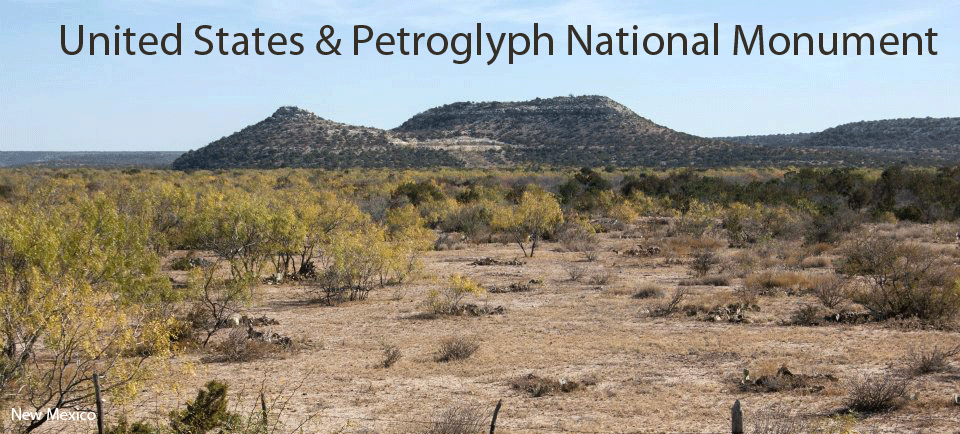
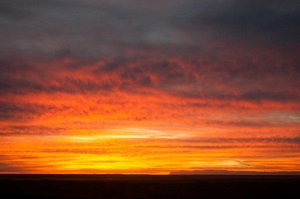
Field Study in New Mexico, March 24-30, 2013
The Written in Rock team regrouped in New Mexico on March 24-30, 2013 where they studied several archaeological sites in the Albuquerque area that share a kinship with the Pueblo participants. Petroglyph and landscape preservation experts from Sacred Sites Research, the National Park Service, as well as staff from the Indian Pueblo Cultural Center, supported and joined the group for this exciting and transformational weeklong exploration of the region.
Participants arrived throughout the day on Sunday, March 24, 2013 with the majority arriving after 9:00 p.m. At the hotel where they were staying, they received a warm welcome from each other and conversations started as if there had not been a break from their visit in October. They had a small welcome party in the hotel lobby and the WIR coordinators circulated orientation packages with the trip itinerary, reading materials, and small gifts from the Smithsonian. The Azerbaijani travelers were very tired after a long flight.
The next morning, Monday, March 25, the team travelled to the Indian Pueblo Cultural Center (IPCC) where they met Marth Becktell, Museum Director, and Travis Suazo, the Executive Director of IPCC. Marth was instrumental in recruiting Pueblo applicants for the WIR program and she supported the group throughout the field study. Larry Loendorf and Laurie White of SSR were also on hand. Everyone formally introduced himself or herself, and then had a guided tour of the IPCC Museum exhibitions. Pueblo participants Lee Francis, Jonathan Sims, and Lorraine Caté led the tour through three exhibits: 100 years of State and Federal Policy: The Impact on Pueblo Nations, Our Land, Our Culture, Our Story, and A:shiwi A:wan Ulohnanne: The Zuni World, A Zuni Map Art Exhibit. One Pueblo participant wrote, “The exhibit was a wonderful learning experience for everyone, and the in-depth commentary and knowledge of the Pueblo guides regarding the displays was powerful.”
During the Museum tour, the group bumped into another Azerbaijani visitor who was unconnected to the program; one Azerbaijani participant remarked, “Even here, on the other side of the world, we met countrymen from Azerbaijan.” Another Azerbaijani reflected on his experience at IPCC:
It was so amazing to me because it was the first time that I was so close to the Indian culture and life. The Museum was full of Indian material culture and art. The most striking exhibits were the pottery samples from different Indian Pueblos and paintings that depicted nature and a combination of petroglyphs and symbols. Luckily, my Indian Pueblo participants assisted me [in understanding] their meanings. While touring the Museum, I saw that some of the Gobustan petroglyphs resembled some of the petroglyphs in New Mexico, such as the illustrations of the Sun, deer, and serpent head boats, etc.
After touring the exhibits, the group celebrated the start of the trip with lunch at the IPCC’s Pueblo Harvest Café. IPCC staff posted a photo of the group on the Facebook Page with a caption about the project.
In the afternoon, the group gathered in the Petroglyph National Monument’s (PNM) conference room at PNM’s Visitor Center building. PNM staff welcomed them: Dr. Joseph Sanchez, Superintendent, Diane Souder, Chief of Interpretation and Outreach, and Mike Medrano, Chief of the Division of Resource Management. Joe, Diane, and Mike presented on the PNM’s history, preservation challenges, relationship with Native American people, and plans for the future.
From the Visitor Center, the group drove with Diane to Piedras Marcadas Canyon, a part of the Petroglyph National Monument, to examine the petroglyphs found on the rock surfaces. Diane explained that the site contains an estimated 5,000 or more documented rock images, most of which were created between 400 and 700 years ago by the ancestors of today’s Pueblo people and other groups traveling through the area. Diane also explained that the site, which is surrounded by the city of Albuquerque, is impacted by changing environmental conditions that are caused by urban expansion. One Azerbaijani participant wrote about Piedras Marcadas:
The site was remarkable because it was located so close to the homes where locals were living. It turns out [PNM] has had trouble preserving the site and are struggling with different [federal and city] regulations.
A Pueblo participant shared his perspective:
[Piedras Marcadas showed the] impact that an urban landscape has on a cultural landscape. We discussed the delicate balance of trying to preserve and protect these ancient markings and sacred areas from the encroachment of today’s urban dwellers. Sometimes [these sites are] loved too much [that they are hurt] by over use. This was in stark contrast to the petroglyphs that we saw at Gobustan where the petroglyphs were not (yet) threatened by urban sprawl.
Another common phenomenon between the two countries was having extinct volcanos near many of the petroglyphs. According to the New Mexico Museum of Natural History and Science Website, New Mexico has one of the greatest concentrations of young, well-exposed, and uneroded volcanoes on the continent. And as a bonus, it is also the Rift Valley state; it has one of only four or five big continental rifts in the world, East Africa being one of the other ones. The fact is, New Mexico is one of the best places to study the natural history of volcanoes. Twenty percent of the U.S. National Parks and Monuments based on volcanic themes are in New Mexico. There are more there than Arizona, Idaho, Oregon, and Washington combined. Several small “steamers” can be seen from Petroglyph National Monument.
After the excursion to Piedras Marcadas, the group reconvened in PNM’s conference room. Larry Loendorf, a leading expert on the study of petroglyphs and the author of several books on the subject, discussed his experience documenting petroglyph landscapes. Laurie White, an artist, photographer, and rock art recorder, who also travelled with the group to Azerbaijan, explained the processes and technologies she uses, both old and new, to record petroglyphs. Laurie’s presentation added to the training she provided in Azerbaijan, where she lectured about advanced recording techniques and demonstrated how to use drawing applications on electronic tablets to trace petroglyphs and their surrounding environments.
After a long day of introductions, field study, and presentations, the participants travelled back to the hotel to have dinner on their own or in small groups. On this evening, and all others to follow, participants were encouraged to reflect in small groups on what they were experiencing, with the intention of creating greater understanding. Reflection was a daily practice started in Azerbaijan, which some participants chose to continue.
One Azerbaijani participant wrote:
We visited many petroglyph sites and at the end of each day gathered together to share our experiences and to discuss what we have learned. […] I think this project was not only important to study petroglyphs but also to exchange cultural values. I was involved in many conversations with the Pueblo participants and I got a chance to learn about Native American culture. It was an enlightening experience for me.
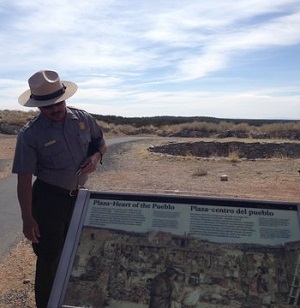
On the morning of Tuesday, March 26, the participants boarded the vans for Gran Quivira and Abo, two parts of the Salinas Pueblo Missions National Monument, located approximately 2 hours from Albuquerque. Larry Loendorf and Laurie White rode in different vans so that they could explain to the passengers the significance of the sites. At Gran Quivira, park ranger Mario Medina explained the history of the location from the perspective of the people who may have lived there. He explained that Pueblo people suffered cultural and religious oppression under Spanish and Catholic rule. At each village the Spanish would locate the most sacred spot, the kiva (a circular room used by Pueblos for religious purposes), and build their church on top to express religious superiority.
From Gran Quivira, the group boarded the vans to travel a short distance to Abo, a site with numerous pictographs (rock paintings) and some petroglyphs. The Abo rangers, Billy Weinman and Gavin Gardner, exposed the group to the recording strategies used at Abo, which included aerial surveillance and advanced technologies. The rangers showed the group the pictographs and petroglyphs located at the site. One Pueblo participant wrote about the experience and connected it to Azerbaijan:
At Abo, we experienced rock paintings that for many members of the group were very spiritual. The majority of these drawings and paintings were associated with salt. Unbeknownst to most members of the group, there were areas located a short distance away where salt was traditionally gathered. Unfortunately, these salt lakes are now located on private land and inaccessible for the gathering of salt. While in Azerbaijan, we also learned of the salt gathering and trade routes. In 2010, archaeologists published research showing the Duzdagi salt deposits, located in the Araxes Valley in Azerbaijan, hold the oldest salt mine known. Intensive salt production was carried out in this mine at least as early as 3500 BC.
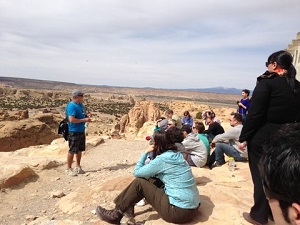
The group re-boarded the vans and travelled back to Albuquerque where they had dinner on their own.
On Wednesday, March 27, the team visited the Pueblo of Acoma (a.k.a. Sky City). During the drive to Acoma, the Pueblo participants pointed out sites along the way. Ann Brierty and Lee Francis showed the Azerbaijanis the location the Laguna Pueblo, which neighbors the Acoma Pueblo. Once the vans arrived at Acoma, the participants visited the Sky City Cultural Center & Haaku Museum, where they visited the exhibits and gift shop, and received their photo permit and admission stub for the tour of the village on the top of the mesa. The group then travelled to Jonathan Sims’ family home. Christine Sims, Jonathan’s mother, and his aunt Teresa, hosted a lunch for the participants. For many of the Azerbaijani participants, this experience was very memorable. Below are some of their comments:
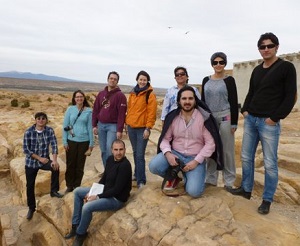
I was struck by Acoma Pueblo and the Cultural Center in the Sky City. That is where we saw how the Native Americans live. At Jonathan’s home, we met with his family and experienced the national cuisine. I want to thank Jonathan and his family for their hospitality. We also prepared a surprise for them [we brought] national sweets in honor of Novruz, the spring holiday in Azerbaijan. Then we went to the village on the mountain. There are no words to describe the feelings that I personally felt when we walked through the Acoma Pueblo streets. It was so incredible and exciting.
The lunch at one of the participant’s family home at Acoma city was the most memorable lunch I have ever had because the environment and the food was quite similar to traditional Azerbaijan culture. I was amazed by their hospitality; it made me feel at home. Hospitality is also a key element of Azerbaijan culture.
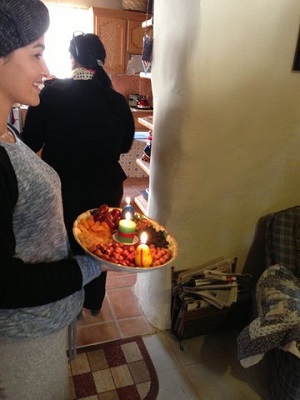
In response to the lunch, one Pueblo participant wrote:
While at Acoma, we were treated by the Sims family to a traditional Pueblo feast. This consisted of roast lamb, lamb stew, roast squash, squash stew, homemade tamales, red and green chili, oven bread, and Indian tea. The meal was similar to the meal we were provided when we visited the sheepherder’s camp in Azerbaijan. Both were such treats! It was great to see our Azerbaijan brothers and sisters enjoying chili from the Southwest.
After lunch, the group travelled to the top of the mesa (an elevated area of land with a flat top and steep sides) where the old Acoma village was located. A tour guide named Dakota led the group through the village while he explained the history and customs of the Acoma people. One Azerbaijani participant wrote:
It was the most interesting and informative part of the program. The tour guide was very well informed about the Acoma Pueblo. He told us the whole history of Native Americans.
After touring Acoma, the group boarded the vans and travelled to Sadie’s Restaurant to eat. AAM’s Dean Phelus joined the group for dinner. Each person stood up, introduced him or herself, and said a few words about their experiences thus far.
On Thursday, March 28 the group travelled to Tsankawi, part of the Bandelier National Monument near Los Alamos, New Mexico.
Park curators Ron Torrez and Gary Roybal (of Santa Clara Pueblo) hosted the group. Ron and Gary talked about the history of the site and led the team through the footpaths towards the top of the mesa where the remains of a village lay intact. Along the footpaths and on the side of the mesa, many petroglyphs were visible. Scholars Larry Loendorf and Nancy Olsen instructed the group on the possible ages and purposes of the symbols. The Pueblo participants also shared their insights about the significance of the site. For example, one Pueblo participant showed the group where the plaza would have existed in the village and compared it to the plaza they saw at Acoma:
We hiked the loop trail through the ancient pueblo site now in ruins. It provided an opportunity to show our Azerbaijan guests what a plaza looked like in ruins. The previous day we had been able to show them a plaza at Acoma that is still in use today. They could visualize what it may have looked like had the buildings still been standing at this ancient site. We were able to show them many examples of pottery shards and pieces of broken arrowheads and stone tools that were still on site. They were able to witness sacred areas and participated in prayers and the offering of corn meal at this place.
For some of the participants, Tsankawi was a sacred place:
We walked trails that were cut and worn deep into the rock through continuous use since ancient times. We climbed wooden ladders to the top of the mesa where we could stand and witness the beauty of the surrounding area. […] This was a spiritual place to many within the group. We also witnessed the many examples of rock writings, some telling of migration, some of settlement, and some of spirituality. For some of us, the day could have all been spent at this place.
At the end of the trek around the mesa, the group sat down for a picnic lunch. The group thanked their hosts and Ron presented the Azerbaijani participants with gifts, each received a book on Bandelier.
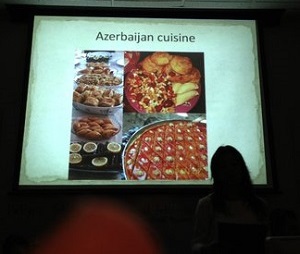
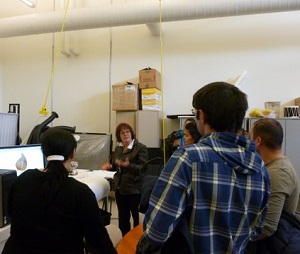
From Tsankawi, the group went directly to the Institute of American Indian Art (IAIA), near Santa Fe. The participants presented to the students of Jessie Ryker-Crawford’s Museum Studies class, along with IAIA faculty, and IAIA’s President Dr. Robert Martin. Each Azerbaijani participant delivered a short speech on one aspect of Azerbaijan—geographical location, tourism, cuisine, clothing and ornaments, textiles and carpets, film, music, and petroglyphs. The Pueblo participants each shared what they learned by travelling to Azerbaijan in October 2012. The audience asked questions and a discussion about the project ensued. The participants’ presentation was followed by a brief tour of the campus and studios.
Friday, March 29 was an extremely busy day, as it was the last full day together in New Mexico. The morning sessions were held at PNM’s conference room. Nancy Olsen, a petroglyph scholar and ethnologist, presented to the group on her research at Tsankawi (she was also on hand during the visit to Tsankawi and IAIA the day before). The hour-long presentation was followed by questions.
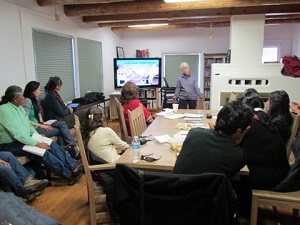
Afterwards, the group was engaged in a “Now What?” exercise. The participants were asked to reflect for 10 minutes on what they planned to do as a result of their participation in the project. They wrote down their ideas. Then, they formed groups of two or three to discuss their ideas and give one another advice on strengthening their ideas. The group reconvened and each person presented their ideas to the whole group. One Azerbaijani participant described the activities as generating “fruitful ideas and valuable [advice] suggested by our friends.” Most participants plan to deliver an educational presentation to their home communities and peers. Some are committed to working with many stakeholders to realize efforts to care for Pueblo ancestral sites. Other ideas ranged from creating a video about WIR and a fashion line, to writing an academic article and publishing a book. One of the coordinators recorded the participants’ ideas on a white board.
One Pueblo participant wrote:
We talk[ed] about the future and what we wished to accomplish with the knowledge we had all gained from the Written in Rock project. All participants greatly benefitted from the program because of this knowledge, and [we gained] a greater understanding of the similarities and differences of our respective cultures.
The “Now What?” activity was followed by an open discussion about people’s ideas and concerns. One Pueblo participant cautioned the group about publically posting images from the trip on social media sites and websites, as some of the images are sacred to some groups of people.
The coordinators then presented the participants with certificates of participation in recognition of their diligent work and commitment to the aims of the project. Participants were free to use the rest of the afternoon to sightsee, shop, and prepare for the evening’s farewell dinner.
The team reconvened in the early evening to board the vans to travel to a restaurant for dinner and reception. The Pueblo participants invited guests, including tribal leaders and members of their families. People from IPCC, PNM, and SSR were also invited. Similar to the last evening in Baku, Azerbaijan, this dinner was both celebratory and sad, as the time spent together was ending. An Azerbaijani participant wrote, “It was an unusual evening. We did not want to leave. We became a family [during our] time [together].” Another participant wrote:
[At the farewell dinner] we gave special presents to each other. We were very glad, as well as sad. It was almost the last day of the project. We would take leave of our dear American friends. But, certainly, I believe that we will never forget each other.
On the morning of Saturday, March 30 the coordinators took the Azerbaijani participants to the airport where they boarded a plane to return home. Two Azerbaijani participants extended their visits in the US and traveled to California. The Pueblo participants returned to their homes (three of the participant’s live in different states, including Arizona, California, and Texas). The coordinators returned the passenger vans and travelled back to their homes.




